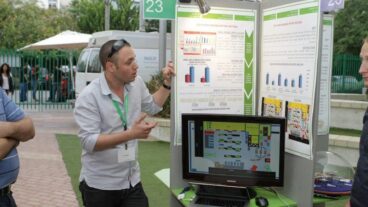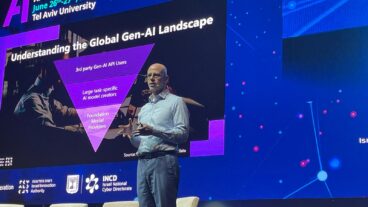Gershon Silbert: We developed a system for analysis – to teach computers what musicians understand, concepts like rhythm, patterns and harmony.That old TV commercial riddle ‘Is it live or is it Memorex’ takes on new levels of complexity if you include Gershon Silbert’s new music composition software in the equation.
The MOR (Music Objects Recognition) programs that the Israeli musician and composer has developed at his company Silpor Music makes it possible for musicians who can read sheet music to perform music without any instruments – just the computer keyboard. And not only that, it can understand specific musical instructions about how to perform the music, including tempo and cadence. Once the techno-musician hears his composition, he can then change parameters to tweak the music to his liking.
“The potential users are producers of music that is more in the background than the foreground – music for films, commercials,” said Silbert. “A composer can finish his whole soundtrack on his desktop without having to ever go into the studio.”
Computer-aide musical composition is nothing new. Musicians have used software programs for years in various ways, like producing demos and notating scores. The problem is that the playback in these applications often sounds… well, like a computer. It’s often mechanical and lifeless and unable to recreate the subtle nuances of a human performer.
That’s where Silbert and his four-year-old Herzliya-based company strike their melody.
“In order to simulate or recreate music with computers, there is an element of rule-based understanding of the text. And the element of expressing it is based on understanding, which can also introduce some personal preference,” Silbert told ISRAEL2c.
“Let’s say you understand that a sentence is emphatic – how would you reproduce it? Some would do it with more bravado, some with less. But first of all, you need to understand what the sentence is saying. The existing systems for music reproduction were not going in that direction.”
Silbert should know a thing or two about music. A pianist from his youth, he attended Julliard and performed in the US for years as a concert pianist. At some point he veered off into the sideline of piano reconstruction, but when he returned to Israel 10 years ago, he decided to return to music, “but in a different format – in research rather than in active performance.
“In the 1990s, I was involved in trying to understand musical issues on a more theoretical and thorough level. The main impetus was discussions with a friend at IBM who told me they were working on a musical expression research project,” he said.
While he almost joined the IBM effort, Silbert eventually decided to pursue a similar project on his own, which led him to founding Silpor.
“I realized that the direction this kind of research was going in wasn’t going to lead to anywhere good, so I decided to put my two cents in,” he laughed. “If you look at the results over the last 50 years or so – the numbers repeated by computerized phone operators or the music played while you’re on hold – in most cases it’s embarrassing. It may work in theory, but not in practice. That’s not uncommon with stuff that comes out of universities.”
With a small staff, Silbert began working on the algorithms that make up the MOR system.
“I wanted real results, so we did two things. We developed a system for analysis – to teach computers what musicians understand, concepts like rhythm, patterns and harmony. Then we set a number of sound parameters – things like density, timing, any parameter than could be modulated, and set up an analyzing engine and a processing engine.”
The software offers preset parameters to get results at the click of a button, but also offers an in-house editor that can change the presets and create new ones.
Instead of calibrating each parameter each time, we have presets that get the results with the click of a button. But it also has an editor that can edit the presets and create new ones. According to Silbert, the plug in software word processing system is geared for anybody who can write music for notation software.
“Most of the work is done by the software behind the scenes – however the user can also do the behind the scenes stuff, or work in an automatic way,” explained Silbert.
A litmus test was conducted recently when Silbert used the MOR to sample a genuine Steinway piano performing the Goldberg Variations. He then sent a CD of the recording to classical music aficionados without naming the performer. According to a report in Ha’aretz, most rated the performance as satisfactory and said it had been without technical faults. But they also noted that the pianist had not displayed extraordinary virtuosity.
That was exactly the response Silbert wanted to receive: the software was able to produce a correct and proper performance that was true to style; what is known as ‘a good performance.’
“So far nobody could tell that the results of the program have a revealing feature that would make it obvious that it’s not human,” Silbert said. “There are human performances that people like and don’t like. It’s an issue of being credible or not credible.”
Electronic Musician magazine lauded the MOR and its ability to create computerized music with human traits: “The Silpor Music Web site includes some examples of pieces performed with and without MOR as well as the same pieces performed by human musicians, and the results are remarkable. This technology is a real boon for composers who wish to hear their work played by a computer with a convincingly human touch. If only it could also make coffee…”
While it can’t boil water as of yet, that comment does raise the issue of what software like MOR means to struggling musicians who could be put totally out of work by a computer. Silbert doesn’t see it that way though.
“Let’s put it this way – the art of performances will never become obsolete. But even today in live performances, there’s a tremendous amount of electronics – digital equipment, enhancing live performances, we’re pretty much used to it,” he said.
“It’s not so much a threat to musicians – in production the cost factor of putting certain things out is so prohibitive, that they’re not being done. So I see this development as enabling certain things to happen that aren’t taking place now.”
According to Silbert, the MOR is part of the trend toward media 2.0 that has overtaken the communications world in the last few years – which he says is often the result of technology dictating what the public wants.
“In a nutshell, there’s a tendency for consumers of media in general to be more interactive. Instead of downloading songs for your Ipod, people want to be more involved in a proactive way – not just accepting what they’re getting.
“I’m not sure if this is going to be the future. Usually it happens because the tools become available. Look at digital cameras – now you can edit your own photos.”
Silpor’s MOR system is in beta testing and Silbert expects to have it on the market by the end of 2007. But Silbert is already hard at work on the next development based on his algorithms – text to speech.
“What we’ve achieved in music proves the capability of text to speech – it’s pulling the same root, the sample library,” Silbert said, adding the applications are endless including customer relation management and call centers, GPS devices, learning education tools, and audio books.
“Most good audio books are read by actors. I can’t see too many people wanting to listen to a book by an existing computerized voice machine. The main thing is that the system has to be such that it is more or less indistinguishable from human speech. That’s what we’ve achieved in music, and voice is next.”![]()
Slashdot It!![]()












